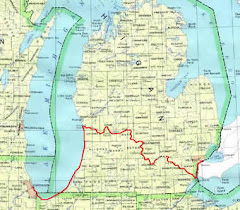"My clothes for this tour consisted of a complete suit of grey flannel for use in the boat, and another suit of light but ordinary dress for shore and Sundays. The 'Norfolk jacket' is a loose frock-coat, like a blouse, with shoulder straps, and belted at the waist, and garnished with six pockets. With this excellent new-fashioned coat, a something in each of its pockets, and a Cambridge straw hat, canvas wading shoes, blue spectacles, a waterproof overcoat, and my spare jib for a sun shawl, there was sure to be a full day's enjoyment defiance of rain or sun, deeps or shallows, hunger or ennui."
Curious about the Cambridge straw hat I went looking on the Internet and sure enough I found a Cambridge Straw Boater Hat at a place called Urban Excess in England. It is a stiff, flat top straw hat with a wide brim (and a black band) specifically for boating on a river. They are priced at 12 pounds (whatever that is in $). I decided I had to have one but they were out of stock.
Verlen always wore a Tilley hat. Son Jim does, too. They are the very best.
Having been successful hunting for the Cambridge straw hat I decided to try the Internet for the Norfolk Jacket and sure enough there it was complete with illustrations. "The principal feature of the Norfolk is the shoulder construction that made it easier to raise a gun to bear on a bird." Two thoughts: MacGregor was a famous shooter and the same action back would have made the Norfolk suitable for paddling.
 You can get a genuine English-tailored wool Norfolk jacket for about the price of a kayak.
You can get a genuine English-tailored wool Norfolk jacket for about the price of a kayak.
As for canvas wading shoes, I wore L.L.Bean canvas canoe shoes on my 1948 trip in a wood and canvas canoe in Western Ontario. I still have them.
MacGregor's thousand miler put him and his Rob Roy on the following European rivers:Thames, Sambre, Meuse/Maas, Rhine, Main, Reuss, Aar, Ill, Moselle, Meurthe, Marne and Seine. Lakes: Titisee, Constance, Untersee, Zurich, Zug and Lucerne. Plus six canals in Belgium and France and two expeditions in the open sea of the English Channel.
On my big drafting table in my "Map Room" I have spread out old National Geographic maps and an old British Bartholemew Atlas and am trying to trace his travels. Although the rivers and lakes haven't moved during the last 144 years the international borders have. Since he wrote his book European borders have changed and changed again thanks to wars and their aftermaths. The Franco-Prussian War, World War I, World War II and the collapse of the Soviet Union all resulted in border changes and new and different countries where he traveled. Trying to trace Velen's travels in detail can be difficult but at least the effort isn't complicated by such changes.
Historically, consider that while he was making his fun preparations in England the Civil War was raging here. Also consider that 5 years after he paddled in France and what is now Germany there was a war going on there, the Franco-Prussian War of 1870.
I am always amazed at the amount of map work Verlen must have done to lay out his trips. Like I am trying to follow MacGregor's route, I have been trying to follow Verlen's and Steve Landick's route on the Ultimate Canoe Challenge using "Google maps".
More on that later













